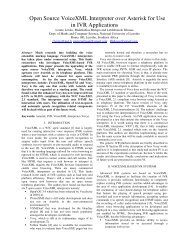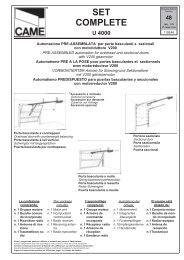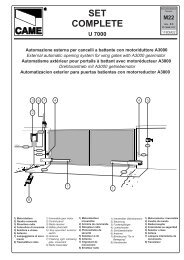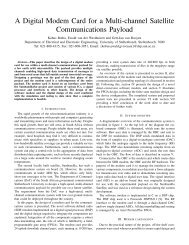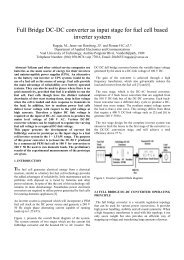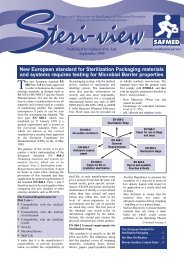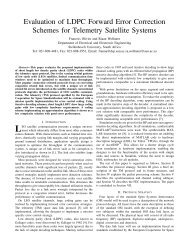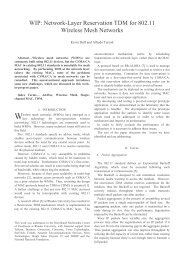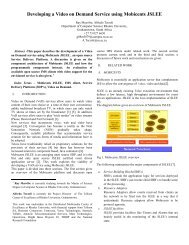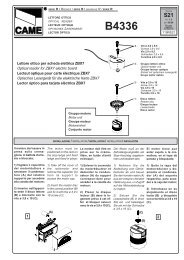Implementation of a web-based E-government proxy for a ... - satnac
Implementation of a web-based E-government proxy for a ... - satnac
Implementation of a web-based E-government proxy for a ... - satnac
You also want an ePaper? Increase the reach of your titles
YUMPU automatically turns print PDFs into web optimized ePapers that Google loves.
<strong>Implementation</strong> <strong>of</strong> a <strong>web</strong>-<strong>based</strong> E-<strong>government</strong> <strong>proxy</strong><br />
<strong>for</strong> a marginalized rural population.<br />
B. T Jakachira; HN Muyingi; and R. Wertlen<br />
Computer Science Department, University <strong>of</strong> Fort Hare, Alice, South Africa<br />
bjakachira@ufh.ac.za, hmuyingi@ufh.ac.za, rwertlen@ufh.ac.za<br />
Abstract: Electronic transactions over the Internet to remote<br />
rural areas may be costly and inefficient owing to poor<br />
connectivity. The system described in this paper aims to bring a<br />
collection <strong>of</strong> <strong>government</strong> services electronically to the rural<br />
public, making these services more available and efficient. Four<br />
s<strong>of</strong>tware modules, <strong>based</strong> on open source standards, have been<br />
developed and integrated to <strong>for</strong>m a single, dynamic <strong>web</strong><br />
component. The e-<strong>government</strong> functionality <strong>for</strong>mulates a<br />
communication channel <strong>for</strong> the <strong>government</strong> to reach out to the<br />
most remote parts <strong>of</strong> South Africa.<br />
Index Terms: s<strong>of</strong>tware modules, RAD, e-<strong>government</strong><br />
functionality, <strong>web</strong> component, communication channel, rural<br />
ICT, <strong>proxy</strong>.<br />
I. INTRODUCTION<br />
The growth <strong>of</strong> computers and telecommunications<br />
technologies value and the proliferation <strong>of</strong> the Internet and<br />
<strong>web</strong> can not be underestimated. As a result we see that<br />
citizens, policymakers, and others have raised their<br />
expectations about the delivery <strong>of</strong> <strong>government</strong> services<br />
digitally. The paper carries a description on the development<br />
and implementation <strong>of</strong> an e-<strong>government</strong> <strong>web</strong>-<strong>based</strong> system.<br />
The system integrates three back-end interfaces which are<br />
system administration, Home Affairs and Municipality<br />
together with one front-end interface, DwesaCitizen. The<br />
whole system allows a remote user to download important<br />
Home Affairs <strong>for</strong>ms and fill them be<strong>for</strong>e uploading them<br />
through to Home Affairs a <strong>proxy</strong>. It allows the users to send<br />
reports to Municipality. The Home Affairs and municipality<br />
will use back-end interfaces to process user applications and<br />
reports [1][8].<br />
The objective <strong>of</strong> the paper is to present the Dwesa e-<br />
<strong>government</strong> (Dwesa-Gov) system which is a s<strong>of</strong>tware<br />
application type <strong>of</strong> product that uses in<strong>for</strong>mation technology<br />
to bring a group <strong>of</strong> <strong>government</strong> services to the benefit <strong>of</strong><br />
citizens, business partners and employees without them<br />
physically contacting the <strong>government</strong> departments. Part <strong>of</strong> the<br />
system name, Dwesa-Gov, refers to the rural area in Eastern<br />
Cape Province called Dwesa, where the e-<strong>government</strong><br />
application will be deployed. With e-<strong>government</strong>, in<strong>for</strong>mation<br />
about the services <strong>of</strong>fered by the <strong>government</strong> through the<br />
different ministries can be circulated quickly down to the grass<br />
root levels [10][11][13].<br />
This paper proceeds as follows. Section 2 briefly describes<br />
some background literature relevant to the project. Section 3<br />
discusses the problem domain this project tackles. The<br />
development and implementation are explained in Section 4.<br />
The conclusion and some possible future works will be<br />
highlighted in the last section, Section 5.<br />
II. BACKGROUND LITERATURE<br />
Any e-<strong>government</strong> system can be seen in terms <strong>of</strong> the<br />
processes implemented. Further a working e-<strong>government</strong><br />
prototype can be created by phased development <strong>of</strong> various<br />
modules which implement increasingly complex functionality.<br />
The figure below shows how e-<strong>government</strong> systems can be<br />
categorized according to the completeness <strong>of</strong> the functionality<br />
they <strong>of</strong>fer citizens versus the complexity required <strong>of</strong> the<br />
systems and the organizational structures <strong>of</strong> <strong>government</strong> itself.<br />
The figure also shows that this development <strong>of</strong> e-<strong>government</strong><br />
system progresses in stages [1][11][12].<br />
Technology and Organization Complexity<br />
Catalogue<br />
Sparse<br />
Transaction<br />
Integration<br />
Vertical<br />
integration<br />
Figure 1. Stages <strong>of</strong> E-<strong>government</strong> Systems<br />
Horizontal<br />
Integration<br />
Complete<br />
There are four stages suggested by the graph above.<br />
• Catalogue: Here the system supports online<br />
presentation and access to downloadable <strong>for</strong>ms. The<br />
1
technology and organization <strong>of</strong> the system at this<br />
stage is less complex because <strong>of</strong> sparse content.<br />
• Transaction: Here services can be accessed<br />
interactively online. Databases support online<br />
transactions at this stage. The research presented in<br />
this paper aims to produce a system prototype that<br />
falls on this level.<br />
• Vertical Integration: supports local systems linked<br />
to higher level systems within similar functionalities.<br />
It focuses on integrating <strong>government</strong> function at<br />
different levels, such as those <strong>of</strong> local <strong>government</strong><br />
and state <strong>government</strong> [12].<br />
• Horizontal Integration: Here system integration<br />
proceeds across different functions. It integrates<br />
separate systems from different departments. This<br />
may be referred to as real one stop shopping <strong>for</strong><br />
citizens. A system at this stage will require advanced<br />
technology and complex organization [1][12].<br />
E-<strong>government</strong> can involve electronic relationships between<br />
<strong>government</strong> and different levels <strong>of</strong> constituents [4]. The theme<br />
behind this theory was applied when the Dwesa-Gov system<br />
was developed. The table below shows only two stages <strong>of</strong> e-<br />
<strong>government</strong> system development against three types <strong>of</strong><br />
<strong>government</strong> relationships.<br />
Table 1. Stages <strong>of</strong> e-<strong>government</strong> growth and type <strong>of</strong><br />
<strong>government</strong> relationship [4].<br />
Types <strong>of</strong><br />
Government<br />
relationship<br />
G2C<br />
(Government-to-<br />
Citizen)<br />
G2G<br />
(Government-to-<br />
Government)<br />
G2B<br />
(Government-to<br />
Business)<br />
Stage 1:<br />
Cataloguing<br />
Online<br />
presentation <strong>of</strong><br />
in<strong>for</strong>mation about<br />
<strong>government</strong> and its<br />
activities <strong>for</strong> the<br />
citizens.<br />
Online<br />
Presentation <strong>of</strong><br />
in<strong>for</strong>mation <strong>for</strong><br />
other levels <strong>of</strong><br />
<strong>government</strong> and<br />
employees<br />
Online<br />
presentation <strong>of</strong> the<br />
in<strong>for</strong>mation <strong>for</strong><br />
business about<br />
<strong>government</strong>.<br />
E.g. online product<br />
review <strong>of</strong> <strong>of</strong>fice.<br />
Stage 2:<br />
Transaction<br />
Services and <strong>for</strong>ms<br />
online to support<br />
online transaction<br />
<strong>for</strong> citizens.<br />
Services and <strong>for</strong>ms<br />
online to support<br />
other level and<br />
<strong>government</strong><br />
Support business<br />
transaction with<br />
<strong>government</strong><br />
e.g. make purchase<br />
<strong>of</strong> <strong>of</strong>fice supplies<br />
online.<br />
It is very important to identify the phase which the e-<br />
<strong>government</strong> system will be in relation to the type <strong>of</strong><br />
<strong>government</strong> relationship [4]. As the table above suggests, the<br />
Dwesa-Gov system lies between the two stages however, with<br />
a more concentrated ef<strong>for</strong>t towards Government-to-Citizen<br />
relationship.<br />
III. PROBLEM DOMAIN<br />
The Dwesa-Gov system was developed <strong>for</strong> Dwesa rural area<br />
in the Eastern Cape province <strong>of</strong> South Africa. The system is a<br />
part <strong>of</strong> an on-going major distributed multi-purpose ICT<br />
(DMPICT) project that has been partly deployed in the area.<br />
The DMPICT project <strong>of</strong>fers various online services to the<br />
rural dwellers. An e-commerce system was developed and<br />
deployed on the plat<strong>for</strong>m to cater <strong>for</strong> the selling <strong>of</strong> the arts and<br />
crafts created by the dwellers. The literacy rate is drastically<br />
low as compared to urban centers [5][16]. The area suffers an<br />
acute shortage <strong>of</strong> basic utilities services. These utilities<br />
lacking in Dwesa include electricity, telecommunication<br />
facilities and tarred roads [5] and lack proper infrastructures.<br />
Poor state <strong>of</strong> the gravel road reduces the attractiveness <strong>of</strong> the<br />
area to transport operators to ply their trade in the area. The<br />
villagers face difficulties to get transport when they want to<br />
visit <strong>government</strong> departments. Villagers spend time, walking<br />
long distances to get to the <strong>government</strong> departments. The three<br />
<strong>government</strong> departments are;<br />
(A) Home Affairs Department.<br />
The closest Home Affairs <strong>of</strong>fice at Willowvale Business<br />
center is approximately 40km from Ngwane rural school.<br />
According to verbal reports, most <strong>of</strong> the villagers queue to get<br />
application <strong>for</strong>ms <strong>for</strong> important documents like identity<br />
documents, birth and death certificates, and various types <strong>of</strong><br />
<strong>government</strong> grants.<br />
(B) Government Municipality.<br />
The municipality department located in Idutywa is about 45<br />
km away from Dwesa area. The municipality <strong>of</strong>fices receive<br />
numerous queries from the villagers some <strong>of</strong> which are:<br />
allocation <strong>of</strong> stands, change <strong>of</strong> address; environmental<br />
problems; infrastructure degradation; problems arising in the<br />
society; land change <strong>of</strong> ownership; housing maintenance; and<br />
road damages<br />
(C) Police Crime Unit Department<br />
Dwesa villagers use cell phones to report life-threatening<br />
problems to the nearest police station. However, mobile tariffs<br />
are beyond the reach <strong>of</strong> already impoverished rural dwellers<br />
and the telecommunication infrastructure in the area face<br />
serious problems during bad weather leading to virtually<br />
unavailable communication. The reports that the villagers pass<br />
to the crime unit department fall into the following categories:<br />
illegal employer, crime <strong>of</strong>fenders in the society, and<br />
environmental threats, e.g. illegal dumping <strong>of</strong> waste,<br />
damaging road signs, etc.<br />
2
The <strong>of</strong>ficials from the crime unit will only be able to help once<br />
the case has been put <strong>for</strong>ward by the villagers.<br />
(D) Dwesa rural community<br />
In urban areas, in<strong>for</strong>mation and news spread quickly than it<br />
does in rural area. In African culture, each village is headed by<br />
a leader who, at anytime, can call <strong>for</strong> public meetings and<br />
gatherings. However, to converge a group <strong>of</strong> people require<br />
telecommunications services. In Dwesa, they use messengers<br />
to send word around if there is an announcement to make. The<br />
Dwesa-Gov system presents a portal to make announcement<br />
that can be read at various designated areas such as, <strong>for</strong> now,<br />
at the four schools that have the computers connected to the<br />
local WIMAX local ro<strong>of</strong>. The portal gives the following<br />
services; announcements, public messages, discussion <strong>for</strong>um,<br />
weather alerts to the public.<br />
The moderator will do the management and verification <strong>of</strong><br />
announcements and the alerts.<br />
IV. SYSTEM DEVELOPMENT<br />
The RAD (rapid application development) s<strong>of</strong>tware<br />
development method was chosen <strong>for</strong> various reasons. The use<br />
<strong>of</strong> this method requires that one gather necessary s<strong>of</strong>tware<br />
engineering tools and language development environments.<br />
The RAD method is ideal because the system uses objectoriented<br />
programming methodology and allows the release <strong>of</strong><br />
working prototypes at frequent intervals. This will allow the<br />
re-use <strong>of</strong> the s<strong>of</strong>tware components and facilitates s<strong>of</strong>tware<br />
version control. Furthermore, the Dwesa-Gov should be split<br />
into a number <strong>of</strong> components since it interacts which various<br />
types <strong>of</strong> users. Developing the Dwesa-Gov system using the<br />
RAD method, the system can be split into several independent<br />
modules that can be revisited and modified individually with<br />
no major changes required <strong>for</strong> modules links[1][2].<br />
Figure 2 suggests that when the RAD system development<br />
method is used, the system prototypes can be iterated to<br />
launch working versions <strong>of</strong> the system, thereby saving the<br />
resources <strong>for</strong> system development [2].<br />
The steps taken to develop the Dwesa-Gov system are briefly<br />
described below.<br />
• Gathering requirements using workshops or focus<br />
groups during Dwesa trips. The e-<strong>government</strong><br />
functionalities were learnt through consultations with<br />
Dwesa citizens.<br />
• Prototyping and early, iterative user testing <strong>of</strong><br />
designs.<br />
• The re-use <strong>of</strong> s<strong>of</strong>tware components<br />
• A rigidly paced schedule that defers design<br />
improvements to the next product version<br />
• Less <strong>for</strong>mality in reviews and other team<br />
communication<br />
The Dwesa-Gov system was developed using open standards<br />
s<strong>of</strong>tware to meet the requirements needed to best fit the<br />
already in-house, MPICT system. The development<br />
Developer’s<br />
Conception<br />
Divergence<br />
Customers’<br />
Conception<br />
Rapid Application Development using Iterative prototyping<br />
JAD<br />
Session<br />
Scope Concepts<br />
requirement<br />
Version 1<br />
Changes features<br />
functions specification<br />
...<br />
Figure 2. RAD system development method, adapted from [2].<br />
<strong>of</strong> the system is expected to enter four phases [1]. The<br />
development <strong>of</strong> the system depended on various factors. Such<br />
factors include the type <strong>of</strong> users the system is targeting, the<br />
size and type <strong>of</strong> content. These and other factors were<br />
compiled and analyzed be<strong>for</strong>e the selection <strong>of</strong> appropriate<br />
s<strong>of</strong>tware tools to use [3]. The system runs using open source<br />
s<strong>of</strong>tware. The Linux operating system provides the ideal<br />
plat<strong>for</strong>m <strong>for</strong> the system. The following s<strong>of</strong>tware was used to<br />
develop the system:<br />
Zoop MVC framework 1.2, an object oriented PHP <strong>web</strong><br />
application framework <strong>based</strong> on a front controller. It is<br />
designed to be very efficient <strong>for</strong> a PHP programmer to work<br />
with. It is easily extendable and you only include the<br />
functionality you use. It features GuiControls; fill AJAX<br />
support and integration; automatic <strong>for</strong>m validation and<br />
creation [14].<br />
Apache Web Server 2.2.6, where the <strong>web</strong> application files<br />
and its framework are stored and accessed by user. The users<br />
will need <strong>web</strong> browser client s<strong>of</strong>tware on their machine to<br />
run the <strong>web</strong> application files [5].<br />
MySQL 5.0.48 database Server an open source relational<br />
database management system that uses Structured Query<br />
Language (SQL) <strong>for</strong> the management <strong>of</strong> user and<br />
administrative data stored in the database tables. It is a<br />
reliable and flexible database server to use [5][15].<br />
Version 2<br />
Re-design<br />
Focus Group<br />
Sessions<br />
Version n - 1<br />
1-21 days<br />
Re-specify Re-evaluate<br />
2-6 months<br />
Total<br />
Package<br />
Version N<br />
3
PHP Version 5.2.4 scripting Language to create dynamic<br />
<strong>web</strong> systems and we realized that it handles user input<br />
efficiently [5].<br />
V. THE FUNCTIONALITIES OF DWESA-GOV<br />
SYSTEM.<br />
The system presents different portals to different type <strong>of</strong> users.<br />
The Dwesa-Gov system was built in to support four types <strong>of</strong><br />
users. The administration center, citizen, municipality and<br />
Home Affairs agencies. The functionalities, as described<br />
below, vary between these types <strong>of</strong> the users.<br />
(A) Administration Center.<br />
The Dwesa-Gov system comprises a portal that allows the<br />
management <strong>of</strong> the system. Special secured passwords were<br />
implemented, using MD5 encryption and One Time Password,<br />
specifically <strong>for</strong> the administrators, to give a maximum security<br />
to the whole system. Administrators have the following tasks<br />
• User accounts management.<br />
• Uploading important application <strong>for</strong>ms.<br />
• Activating user services as plug-ins.<br />
• Acts as an intermediary between the citizens and the<br />
third parties.<br />
The Dwesa-Gov system provides communication channels<br />
between the four users, managed and monitored by the<br />
administrator.<br />
(B) Dwesa rural Citizen Portal<br />
The whole project was developed to serve mainly the rural<br />
people situated in Dwesa. The Dwesa-Gov system provides<br />
the citizens with a user-friendly portal that has links to the<br />
three special services developed as shown in Figure 3 [13].<br />
The citizens require registering in order to access any <strong>of</strong> the<br />
following services<br />
• Online Reporting Center (ORC).<br />
• Online Application Center (OAC).<br />
• Dwesa Forum Corner. (DFC)<br />
The ORC portal allows citizens to launch reports and<br />
complains to the Municipality. The categories <strong>of</strong> reports are<br />
well-handled to make the system efficiently. The reports are<br />
loaded in a database table accessible by Municipality agents<br />
only.<br />
The OAC portal presents a <strong>government</strong>-to-citizen type <strong>of</strong><br />
<strong>government</strong> relationship. The OAC system would be a <strong>proxy</strong><br />
that allows villagers to retrieve from Dwesa Server and the<br />
OAC portal will uses the <strong>proxy</strong> to automatically download and<br />
upload to the Home Affairs server during the low traffic time.<br />
The portal is in its infant stage where downloadable<br />
applications <strong>for</strong>ms have been made available to the citizen.<br />
The application <strong>for</strong>ms are always up-to-date as methods <strong>of</strong><br />
<strong>web</strong> scraping were applied to exchange bits <strong>of</strong> in<strong>for</strong>mation<br />
between the OAC portal and the home affairs. The OAC<br />
module has been enhanced to give the citizens a capability to<br />
upload the<br />
Dwesa Villagers<br />
Interface.<br />
Front-End<br />
Modules will<br />
be accessible<br />
to the Dwesa<br />
villagers. They<br />
are three <strong>of</strong><br />
them.<br />
Dwesa Citizen<br />
database will<br />
store files and<br />
applications<br />
<strong>for</strong>ms.<br />
Back-end<br />
Modules will<br />
be accessible<br />
to<br />
Administrator<br />
and the third<br />
parties.<br />
Communication<br />
through the Internet<br />
will be through a <strong>proxy</strong><br />
All application<br />
<strong>for</strong>ms will be<br />
uploaded to H.A<br />
Web servers<br />
Apache Web<br />
Server<br />
OAC<br />
Dwesa-Gov Proxy Server<br />
Web<br />
Users Portal<br />
ORC<br />
FRONT-END MODULES<br />
Modules<br />
H.A<br />
MySQL<br />
Database<br />
MUN<br />
DFC<br />
ADM<br />
BACK-END MODULES<br />
Modules<br />
Home Affairs Server<br />
Figure 3. Dwesa-Gov System Architecture [13].<br />
<strong>for</strong>ms to the Home Affairs server <strong>proxy</strong>. Technically, users<br />
upload <strong>for</strong>ms to the database table and the OAC system will<br />
use <strong>proxy</strong> to upload the files to the Home Affairs server.<br />
Security measures are being put on place to prevent misuse <strong>of</strong><br />
the service. Such measures include the use <strong>of</strong> encryption in<br />
transmission methods. The system only accepts a number <strong>of</strong><br />
applications <strong>for</strong>ms already defined in the system. The file<br />
sizes, structure and type has played a central role to monitor<br />
the abuse <strong>of</strong> the Dwesa-Gov system’s OAC portal.<br />
The DFC portal provides a communication plat<strong>for</strong>m <strong>for</strong><br />
Citizen-to-Citizen type <strong>of</strong> <strong>government</strong> relationship. The <strong>for</strong>um<br />
portal has been deliberately reduced to a small but<br />
sophisticated system. The <strong>for</strong>um lacks some real features <strong>of</strong><br />
content management system. This was done to simplify the<br />
portal to targeted citizens who are computer illiterate. The aim<br />
<strong>of</strong> the <strong>for</strong>um is to give the rural villagers a functionality to<br />
send announcements and to <strong>of</strong>fer public notices to the<br />
villagers. Announcements are verified from the administration<br />
center be<strong>for</strong>e they are published on the site. Furthermore, the<br />
<strong>for</strong>um portal cater <strong>for</strong> public discussions, however there is a<br />
4
limit <strong>for</strong> the messages that a citizen can send. A system feature<br />
was implemented to enable citizens’ manage their own system<br />
accounts.<br />
(C) Home Affairs and Municipality Portals<br />
The Dwesa-Gov system has back-end interfaces <strong>for</strong> the<br />
Municipality Offices. The citizens will send the applications<br />
and queries to Dwesa-Gov System’s database during the day.<br />
The system can be set up to automatically upload, during the<br />
night, the applications <strong>for</strong>ms to the Home Affairs server<br />
through a <strong>proxy</strong> to limit the access to the Dwesa villagers<br />
only. This is done to deliver <strong>of</strong> files efficiently to the Home<br />
Affairs during low traffic time. For processing and responding<br />
to the queries, the Municipality agencies are presented with a<br />
portal. Home Affairs back-end interface will act as an<br />
alternative way <strong>for</strong> the Home Affairs department to access the<br />
submitted application <strong>for</strong>ms. Home Affairs portal will be only<br />
accessible by the department <strong>of</strong>ficials. Security features are<br />
being investigated are sufficiently strong to en<strong>for</strong>ce the rule.<br />
These include special passwords given to municipalities. The<br />
<strong>government</strong> department <strong>of</strong>ficials (GDO) will get the filled<br />
application <strong>for</strong>ms and process them and will respond to the<br />
citizen via the Home Affairs back-end portal and this mode is<br />
used only when automatic upload scheme <strong>of</strong> the Dwesa-Gov<br />
system is <strong>of</strong>f. Automatic upload increases efficiency as GDO<br />
or Municipality <strong>of</strong>ficials may experience unacceptable delay<br />
when downloading filled <strong>for</strong>ms during the day time. The same<br />
benefit stand <strong>for</strong> Dwesa Villagers when trying to download<br />
and/or upload directly to Home Affairs servers.<br />
Municipality back-end portal will show all the sent messages<br />
and inquiries. The latest inquiries are shown on top and<br />
functionality was added <strong>for</strong> them to respond to the inquiries to<br />
the respective citizen. The Dwesa-Gov system has developed<br />
to simplify the link between the Government and its citizens,<br />
how ever, on reporting cases to the municipality, the system<br />
insists that it will, by no means, be used to communicate life<br />
threatening situations.<br />
All the functionalities that the Dwesa-Gov system <strong>of</strong>fers are<br />
modeled around the Dwesa villagers. The access <strong>of</strong> the<br />
Dwesa-Gov system will start at education institutions level.<br />
The system will be accessible from four schools in Dwesa<br />
where computers are available. Special training sessions will<br />
be given to the teachers and students on how to make use <strong>of</strong><br />
the functionalities. Our hope remains that the villagers will be<br />
allowed to use these computer facilities at the four schools.<br />
The Dwesa-Gov system is an addition to the ICT multipurpose<br />
plat<strong>for</strong>m’s functionalities. Several other systems with different<br />
functionalities are in process <strong>of</strong> being developed.<br />
VI. CONCLUSION AND EXTENSIONS.<br />
We have reported on the development <strong>of</strong> the Dwesa-Gov<br />
system developed to bring <strong>government</strong> services closer and<br />
faster to Dwesa rural villagers. The development <strong>of</strong> the<br />
prototype system demonstrates the use <strong>of</strong> the RAD system<br />
development method, but the system required a determined<br />
approach to security features. The experience from this project<br />
provided an ideal proposal <strong>of</strong> an improved communication<br />
channel between the <strong>government</strong> and its citizens using the e-<br />
<strong>government</strong> <strong>proxy</strong> functionality. Some directions <strong>for</strong> future<br />
work include the following.<br />
(A) Localization <strong>of</strong> Dwesa-Gov front-end portal.<br />
The Dwesa-Gov system was developed using open s<strong>of</strong>tware<br />
standards that are written in English language. However,<br />
necessary measures were taken to ensure that the front-end<br />
interfaces <strong>for</strong> the system can be modeled into system that<br />
con<strong>for</strong>ms within the environment and the society that it serves.<br />
Localizing the system linguistically and culturally ensure the<br />
reliability, flexibility and high adoption rate <strong>of</strong> the e-<br />
<strong>government</strong> <strong>proxy</strong> system. The system was built in modular<br />
fashion, making it easy <strong>for</strong> modeling. The system<br />
development method and s<strong>of</strong>tware used makes version<br />
controlling an easy task. More and more versions can be<br />
developed through iterating between the system components<br />
built around the current system [6][8].<br />
(B) Vertical integration <strong>of</strong> Systems<br />
Vertical integration <strong>of</strong> systems exists when there is support <strong>for</strong><br />
local systems to link to the higher level systems within similar<br />
functionalities. The Dwesa-Gov system can bring together<br />
some functionality that can be available from higher level<br />
systems. Government departments in South Africa can also<br />
have some regional stand-alone systems that are familiar and<br />
can be linked to the Dwesa-Gov system and provide a vertical<br />
integration. Further studies can be done to initiate<br />
Government-to-Business (G2B) type <strong>of</strong> <strong>government</strong><br />
relationship. The idea will to <strong>of</strong>fer support <strong>for</strong> business<br />
transactions with <strong>government</strong>, <strong>for</strong> instant, making purchase <strong>of</strong><br />
<strong>of</strong>fice supplies online [1][4].<br />
(C) Automated Management<br />
In the present version, besides <strong>of</strong>fering automatic upload and<br />
download to and from Home Affairs and Municipality<br />
Servers, maintenance and updating <strong>of</strong> the content is done<br />
manually. Our system heavily relies on the system<br />
administrator’s presence. In future, some automation will be<br />
required to be implemented to increase the level <strong>of</strong> reliability<br />
<strong>of</strong> the system. At further stage, public notice LCD screens <strong>for</strong><br />
public announcements and weather alerts in public places will<br />
be provided and supported by the Dwesa-Gov system. Further<br />
studies will initiate the use <strong>of</strong> SMS notifications to speed up<br />
the delivery <strong>of</strong> public announcements to the villagers [6].<br />
(D) Security Enhancement.<br />
When developing the Dwesa-Gov system, we have seen that<br />
the system handles much input from the users. The most<br />
important security measure required in the Dwesa-Gov system<br />
was to secure file uploads. We used a system-generated file<br />
5
names instead <strong>of</strong> names supplied by the users when storing<br />
file on the system. This would prevent local inclusion attacks<br />
and also make any kind <strong>of</strong> file name manipulation by the user<br />
impossible. Whilst we strived to ensure that the Dwesa-Gov<br />
system meets the security standards, we propose future work<br />
will have to look on how applications uploads and downloads<br />
can be digitally signed. This will prevent malicious use <strong>of</strong> the<br />
Dwesa-Gov system [8].<br />
VII. ACKNOWLEDGEMETS.<br />
We would like to thank the contribution made by the National<br />
Research Fund (NRF) body and the University Of Fort Hare<br />
Centre Of Excellence <strong>for</strong> the support. I want to extend my<br />
gratitude to the Dwesa team <strong>for</strong> making the deployment <strong>of</strong> the<br />
Dwesa-Gov system possible.<br />
REFERENCES.<br />
[1] R Heeks, Implementing and Managing E-<br />
<strong>government</strong>: An International Text. London,<br />
Thousand Oaks, Calif.: SAGE, 2006. Online:<br />
http://worldcat.org/wcpa/isbn/0761967923.<br />
[2] W Maner, Rapid Application Development,<br />
Department <strong>of</strong> Computer Science, Bowling Green<br />
State University, Revised in 1997.<br />
Available:<br />
http://cs<strong>web</strong>.cs.bgsu.edu/maner/domains/RAD.htm.<br />
[3] N Kamar, Impact <strong>of</strong> e-Government on Management<br />
and use <strong>of</strong> Government In<strong>for</strong>mation in Kenya:<br />
Government In<strong>for</strong>mation and Official Publications<br />
2007.<br />
[4] Christopher G. Reddick, “A two-stage model <strong>of</strong> e-<br />
<strong>government</strong> growth: Theories and empirical evidence<br />
<strong>for</strong> U.S. cities,” Government In<strong>for</strong>mation Quarterly<br />
21, no. 1 (2004): 51-64.<br />
[5] S.G Njeje, A. Terzoli, H.N Muyingi, <strong>Implementation</strong><br />
<strong>of</strong> an online shopping mall <strong>for</strong> Dwesa rural area at<br />
Eastern Cape <strong>of</strong> South Africa. University <strong>of</strong> Fort<br />
Hare, Alice, South Africa, 2006<br />
[6] Christine W. Chan, Lin-Li Hen, Liqiang Geng,<br />
Knowledge engineering <strong>for</strong> an intelligent case-<strong>based</strong><br />
system <strong>for</strong> help desk operations, Department <strong>of</strong><br />
Computer Science, University <strong>of</strong> Regina, Regina,<br />
Sask, Canada S4S 0A2, 2000.<br />
[7] Philip Doty, Sanda Erdelez, “In<strong>for</strong>mation micropractices<br />
in Texas rural courts: methods and issues<br />
<strong>for</strong> E-Government,” Government In<strong>for</strong>mation<br />
Quarterly 19, no. 1 (2002): 369-387.<br />
[8] Allan Bezroutchko, Secure file upload in <strong>web</strong><br />
application, Scanit, The security Company, Bld. Du<br />
Roi Albert II, 27, B-1030, Brussels, June 2007.<br />
[9] L. Stojanovic, A. Abecker, N. Stojanovic, R. Studer,<br />
On Managing Changes in the ontology-<strong>based</strong> E-<br />
governement Government, FZI-Research Center <strong>for</strong><br />
In<strong>for</strong>mation Technologies at the University<br />
Karlsruhe. 2006.<br />
[10] Z. Ebrahim, Z. Irani, E-<strong>government</strong> adoption:<br />
architecture and barriers, Department <strong>of</strong> In<strong>for</strong>mation<br />
Systems and Computing, In<strong>for</strong>mation Systems<br />
Evaluation and Integration Network Group, Brunel<br />
University, Uxbridge, Middlesex, UK, vol. 11, No. 5,<br />
2005. pp. 589-611.<br />
[11] Nerisa Kamar, Millicent Ongo’ndo, <strong>Implementation</strong><br />
<strong>of</strong> E-<strong>government</strong> systems – <strong>web</strong>site creation, Egerton<br />
University, J.D Rockefeller Research Library, Njoro,<br />
Kenya, 2007.<br />
[12] Karen Layne, Jugwoo Lee, Developing fully<br />
functional E-<strong>government</strong>: A four stage model,<br />
University <strong>of</strong> Nevada Las Vegas, Las Vegas, USA,<br />
2001. Available: http://www.sciencedirect.com.<br />
[13] A. Gugliotta, L. Cabral, J Domingue, V Roberto, A<br />
Semantic Web Service-<strong>based</strong> Architecture <strong>for</strong> the<br />
interoperability <strong>of</strong> E-<strong>government</strong> Services,<br />
Department <strong>of</strong> Computer Science, University <strong>of</strong><br />
Udine, Udine, Italy, 2006.<br />
[14] Zoop Website: http://zoopframework.com/<br />
[15] MySQL <strong>web</strong>site: http://www.mysql.com.<br />
[16] Lorenzo Dalvit, Alfredo Terzoli, Hyppolite Muyingi,<br />
Mamello Thinyane, “The deployment <strong>of</strong> an e-<br />
commerce plat<strong>for</strong>m and related projects in a rural<br />
area in South Africa”, International Journal <strong>of</strong><br />
Computing and ICT Research Volume 1(1) 2007, pp<br />
9-17.<br />
AUTHORS<br />
B.T Jakachira received a B.Sc Honours degree in Computer<br />
Science in 2007 from the University <strong>of</strong> Fort Hare. He is<br />
currently studying <strong>for</strong> his M.Sc degree in Computer Science at<br />
University <strong>of</strong> Fort Hare. His studies are funded by National<br />
Research Fund (NRF) foundation in South Africa. Developing<br />
s<strong>of</strong>tware applications is his main interest.<br />
Hyppolite MUYINGI, PhD. (EEEng) VUB, Belgium is a<br />
pr<strong>of</strong>essor in the Department <strong>of</strong> Computer Science at<br />
University <strong>of</strong> Fort Hare and Head <strong>of</strong> Fort Hare Center <strong>of</strong><br />
Excellence. His main areas <strong>of</strong> academic interest are ICT <strong>for</strong><br />
development, networks, and communications technologies <strong>for</strong><br />
power utility industry.<br />
R. WERTLEN, B.Sc.Hons (1995) distinction, B.A (1995),<br />
Rhodes, SA, is a M.Sc Computer Science student at Fort Hare<br />
and founder <strong>of</strong> eKhaya ICT. His interests are in ICT4D,<br />
distributed and peer-to-peer systems. He is also Telkom<br />
Center <strong>of</strong> Excellence Coordinator at Rhodes University.<br />
6



